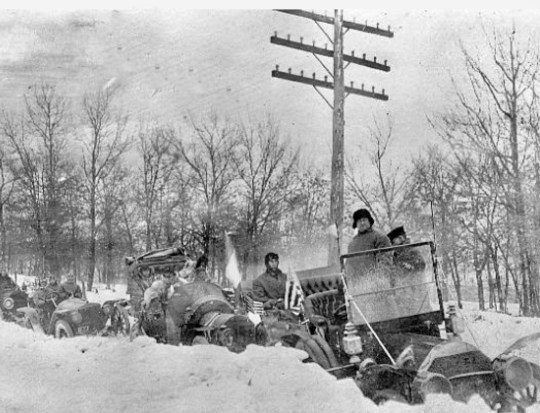
I ended my first post on the 1908 Great Race from New York City to Paris with the six competitors zooming down Broadway on their way out of New York City as a crowd of 250,000 roared them on. Their original route had already been changed by the organizers. Instead of driving half way across the US and then up though Canada to the Bering Strait, they would work their way across the nation and then take a boat up to Valdez where they would continue the Alaska portion of the race over dog sled trails and ice-covered rivers.
But first they had to get across the US starting in winter, no small task considering no one had ever accomplished it. Roads would be rough to non-existent. There were no maps or gas stations, or asphalt— it had yet to be invented. In some areas the drivers would be forced to drive over railroad tracks, a guaranteed bumpy ride! Remember the ads when automobile manufacturers would show how good the shocks on their cars were by driving down railroad tracks with an egg balanced on a spoon? You would have to fast forward to the 60s and 70s for that level of suspension.
Problems began immediately. The one-cylinder, small French Sizaire-Naudin dropped out of the race on the first day at mile 96 with a broken differential. The remaining five vehicles soon found themselves plowing through two feet or more of snow in a blizzard. Except in cities, no handy-dandy horse drawn snow plows were around to clear roads. George Schuster, the mechanic for the Thomas Flyer, walked ahead of his vehicle poking a stick into the snow to measure its depth. Or maybe he was looking for the road!

The slow progress came to a dead halt in Dismal Hollow outside of Auburn, New York. The name alone suggests a horror-story-level disaster. The cars became hopelessly bogged down as night approached. Fortunately, horses hired by the Italian Zust team came to the rescue of the automobilists, as they were known then, and pulled them out.
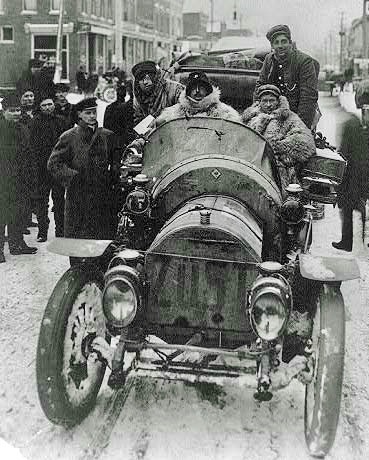
At first, the teams worked together, taking turns at leading. That didn’t last long. It was a race, after all. You can imagine how the Americans, or the Germans or the Italians reacted when the driver of the French de Dion, St. Chaffray, ordered them, “When you wish to go ahead to a city, you ask me.” Right.
The Europeans were soon complaining that the Americans had unfair advantages. When the Thomas Flyer had a problem, dozen of patriotic volunteers jumped in to eagerly help out for free. When the European cars hit a glitch, they had to pay. “They even charge us to sleep on the ground,” one of the drivers whined. A more legitimate complaint in terms of the race outcome was that the railroad and trolley companies favored the Flyer in allowing track usage. Out West, the Union Pacific even scheduled the Flyer to use its tracks like it would a train.

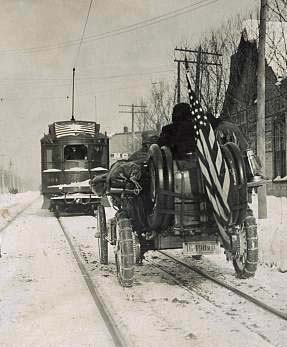
My sense is that the great advantage the Flyer had was George Schuster, however. For one, he had the ability to fix any problem the car had. Each night he would tune the engine and work on whatever else was needed to get the car ready for the next day. The competition complained to the race committee that Schuster had rebuilt the whole car. Possibly. But the complaint was rejected. One of the nightly chores that all of the car mechanics performed was draining the radiator so it wouldn’t freeze. Anti-freeze had been developed but it was used in making bombs, not protecting cars on cold nights
Schuster’s support in keeping the vehicle operating went far beyond his mechanical abilities, however. If someone had to walk 10 miles in a freezing weather to get gas or a part, he did it. If the car needed rescuing from a snow drift or was stuck in a gully, he figured out how to free it. He was dedicated to doing whatever it took to keep the Flyer running.
I suspect a fair amount of money exchanged hands when the racers reached Chicago. Many felt that the cars would be lucky to get out of New York and even E.R. Thomas, the manufacturer of the Flyer, never expected his vehicle would get beyond the Windy City. T. Walter Williams, the New York Times reporter assigned to the Thomas Flyer, bailed out when the cars arrived in Chicago. “It’s insanity” he proclaimed. And it was. But all five cars made it to Chicago and continued on. Snow continued to plague the drivers as they made their way across the Midwest. And when they finally got through the snow, they were faced with hub-deep mud. Lots of it. Tensions soared.
When the De Dion got stuck in a snowbank and Hans Hendricks Hansen, who claimed he had piloted a Viking Ship to the North Pole solo, couldn’t get it out, St. Chaffray exploded. The men decided a duel was in order and went scrambling to find their pistols. Fortunately, they were buried deep in the gear and St. Chaffray had time to decide that it would be better to fire Hansen than to kill him— or be killed by him. Hansen joined the Thomas Flyer, pledged allegiance to the American flag it flew, and swore that he could walk to Paris faster than St. Chaffray could drive there.
Our recent 8,000-mile journey around the US was bound to cross the route of the Great Race. It happened in Nebraska as we followed US 30 along the South Platte River. The racers had been following what would become Highway 30 through Illinois, Iowa and Nebraska. We joined the highway in Kearny and followed it on to North Platte where we stayed at Buffalo Bill’s ranch. Signs along the road proudly proclaimed it had been part of the Oregon Trail and the Lincoln Highway, America’s first transcontinental highway. Before that, it had served as a major path for Native Americans and mountain men. When the route had passed through Omaha on entering Nebraska, the Flyer team met Buffalo Bill who had invited them to stay at his ranch on the North Platte.

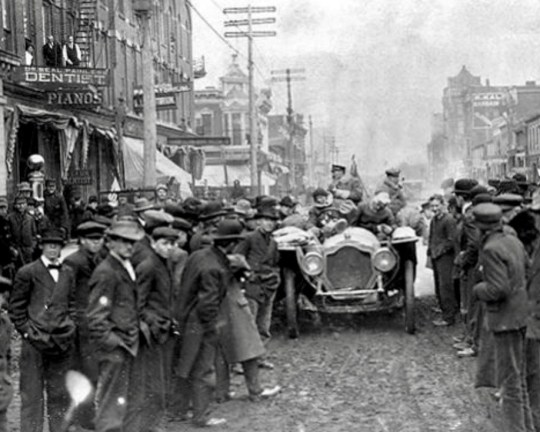

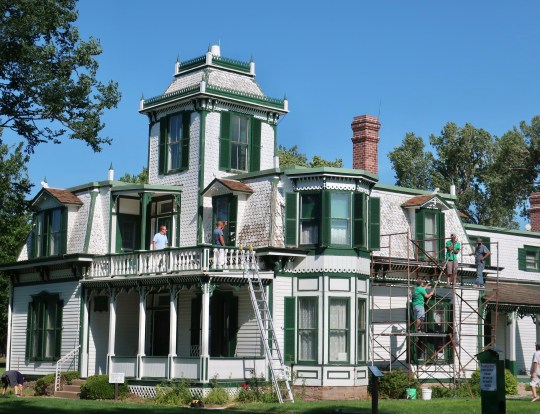
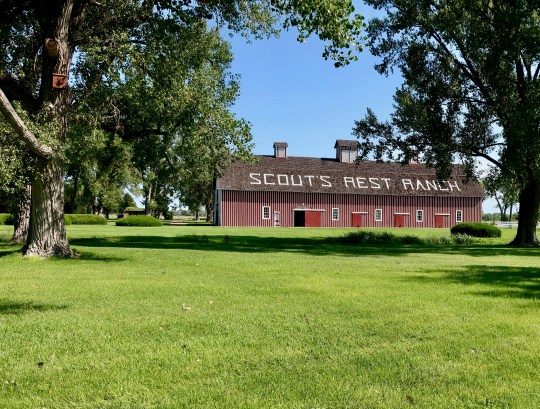

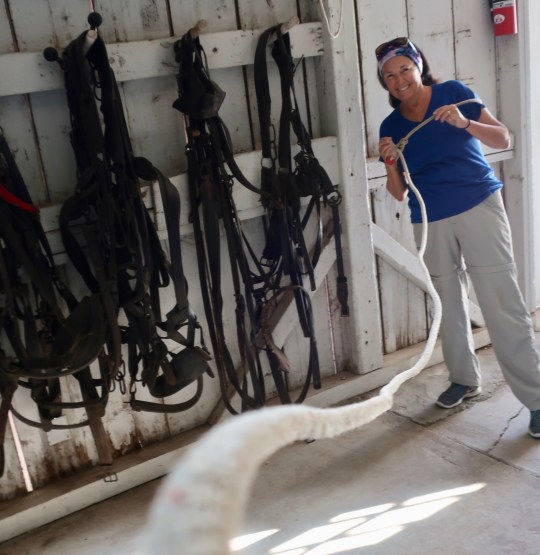

NEXT POST: On to the West Coast and up to Alaska…
Such Great history Curt and great pictures!!!! ❤️ Cindy
Yes
Aren’t those photos fascinating, Cindy. They almost tell the story by themselves. Most come form our national archives. And I was fascinated with the history. I’ve read numerous articles with the best coming from the Smithsonian Magazine and the New York Times. The National Automobile museum in Reno was also a great source. Thanks. –Curt
Oh they were amazing and I plan on going back to them when I get some time. YOu did an amazing job on that. The Smithsonian never disappoints nor does the NYT. ❤️❤️❤️
Thanks, Cindy. Appreciated. We subscribe to both the Smithsonian and NYT. 🙂
I knew they all ran into trouble, but never knew it was this bad! I love Bill’s house. I take it, it’s a museum these days? The ranch looks well taken care of.
Right you are, G. It is a museum. Unfortunately, we arrived on a day it wasn’t open. The barn, however, was a lot of fun, packed to the gills with Buffalo Bill stuff. I’ll probably do a separate post on it. Trouble is a good description. Imagine going through a blizzard in an open convertible for starters. 🙂 –Curt
I may be sick of the heat around here, but going through a blizzard in a convertible is a bit too insane!
You are not alone in that thought, G! 🙂 –Curt
Nebraska is my home state. Just so you know, there is the city of Kearney (lived there for almost 12 years) and the old Fort Kearny. A post office error changed the spelling.
Thanks, Peggy. –Curt
What fun history! Also Buffalo Bill’s house looks AMAZING!
Fun history indeed, MB. I loved learning about it. Peggy and I were sorry that Buffalo Bill’s house wasn’t open when we visited. But the barn was great. I will probably do more on it. Thanks. –Curt
What an amazing adventure Curt – that I knew nothing about. Having to contend with all that snow seems nearly impossible – let alone bumping along railroad tracks. I guess George Schuster was determining the “mark twain” of early auto racing. Thanks for the great photos and detailed account. Looking forward to Part III. ~Terri
Indeed, Terri. I don’t think Schuster had Twain’s sense of humor, though. Dedication, yes! I never knew about the race until I came across references to it in Tonapah and Goldfield, Nevada. I quickly became fascinated with the adventure and had to learn more. Finding the Thomson Flyer at the National Automobile Museum in Reno was like finding a gold mine. Thanks. –Curt
That’s hardcore racing. But for some reason, I’m reminded of an old movie, “It’s a mad, mad, mad, mad world.” Ring any bells?
Someone else had mentioned the same thing, Dave, and I had looked it up. As I recall, it took place in Scotland. I should order it. There is also the movie, “The Great Race,” which was based on the NYC to Paris race, loosely, and was made in 1965. I did just buy it and found it quite fun. Thanks, Dave. –Curt
What a fun post! Somehow your picture of Nebraska reminded me of my last trip to the East Coast. Nebraska seemed to go on forever. Very nearly as long as driving across Texas to San Antonio. I bet there are plenty folks who have not the least idea of just how vast this country is.
Then again, that very last pic made me thing they just don’t make cars like they used to… can you imagine some modern car making it through that? Them guys were just plain nuts!
Laughing. “Just plain nuts,” fits perfectly. And those vehicles had personality!
Nebraska does seem to go on and on. Having ridden my bicycle across Texas, however, I have a different feel for how wide it is. 🙂 You are absolutely right about how vast the nation is. Thanks, Gunta. –Curt
Also laughing: “Having ridden my bicycle across Texas”… that, too, my friend is just plain nuts! 😀
It’s good to be a little crazy. 🙂
I have just heard about this but speaking practically never knew it was so bad. Every history tells its story.. Great work done. Amazed by this article. 🙂
Glad you enjoyed the post. I only learned about The Great Race a few years ago and became fascinated with the story after I saw the actual Thomas Flyer at the National Automobile Museum in Reno, Nevada. It was fun doing the research. Thanks. –Curt
Gr8. 😀
Thanks!
Hey what if you explore India someday buddy India is a country with about 87000gods also known as the land of gods
I’ve never been to India but I would like to go someday.
Yes please you are gonna have great experience
Please follow dailynewzs.wordpress.com
Not only that it is the most diversified country in the world where there is no official religion
Which is a good thing. 🙂
Yes, don’t forgot to follow me and I’m just a beginner it will help me alot I’ll be grateful to you😃
Well, could take that in a few ways, but i suspect i know what you mean 🙂 lol
Just think only a few decades ago the hindu and sikh population were gutting eachother much akin to the protestants and catholics in ireland… my how religion and piety + humbleness sure do get brought out in organized, stratified man crafted institutions!
But the irony of religion specifically, and those that look down on atheists or “agnostics” (a=without, gnostic = knowledge, so technically every theist and atheist is agnostic, just a question to what degree… strong, weak, etc.. etc..) makes my stomach turn.
The fact that in america the group single most discriminated against is…. you guessed it: atheists.
NO PERSON WHO OPENLY QUESTIONS, or heaven (lol) forbid, claims…, THE EXISTENCE OF ALL POWERFUL TIMELESS ENTITY OR BEING will ever become president. At least not in my lifetime, so maybe the pendulum swung a liiiiittle too hard in the religiosity direction after the civil war…. much to do with the reconstruction era , but also because of those who first ventured over to the Americas being generally persecuted for their faith…
The strange thing for me is, say Minnesota, where the first rehab centers and seemingly most empathetic voting population is when it comes to criminality & drug addiction resides (at least when the first centers were developing a system of recovery and not punitive like the rest of the country… at the time and even now is still stuck in mindset wise…) can be founded by such more religious people… but be more caring to their kin and neighbors, where in liberal california, even in the extremely conservative areas in the north, the mentality seems to be “punish” etc, and then we wonder why recitivism rates are so high and the world looks at us as hypocrites.
the war on drugs was named as such so that the defense budget could be used as the administrationS saw fit…. pot / hippie was code for anti war protestors / anti war in vietnam types, crack/heroin was code for blacks, etc.
it is known and on record that the nixon administration has it on record that the aim was to stoke fear in the voters, (sound familiar?) preying on the xenophobia, and look what we have today? ANOTHER institution that sustains itself by ignoring scienctific data, claiming to be for one goal, while directly having the opposite effect, and the only reason it still exists is because just like the military industrial complex, it became too big to fail, and too many people are on the payroll.
With not one single person or group able to make even the smallest dent in the policies… from the DEA, to the sheriffs departments, to the jails…. they all make $
And who profits most??? Not the private prisons…
Pharmaceudical companies… go figure? They are the new giants who have lobbyists even in areas you would never guess….. private prisons with empty cells are like hotels with empty beds. the state gets charged MILLIONS for every bed not filled, so the impetus is on the law makers to keep drug laws PUNITITIVE not rehabilitative. and people behind bars who get 3 felonies for posessing a plant that is marked legally as destructive and dangerous as black tar heroin. MAJIUANA. people still are in prison for crimes associated with it. or had their small time crime ratcheted up by decades because of the fact they had some small non drug dealing amount of substance on or near them….
RANT OFF
A considerable rant, TJ. I can see you put a lot of thought into it. My thoughts run down similar paths. Thanks for taking the time to express your ideas. –Curt
I smiled when the snow turned to mud. In 1927 or so, the Harlem Globetrotters were coming to Melcher, Iowa, to play an exhibition game. The game had to be cancelled because the Globetrotters’ Model A’s bogged down in the mud, and couldn’t make it. The town (where my parents were born and raised) was sorely disappointed.
I recently realized I’ve never been to Nebraska. I didn’t even know where Hwy 30 was. It’s interesting, because my paternal great-grandparents lived in a soddy there for a while, and I have a photo taken in Burwell, but that’s it. Maybe it’s time for an exploration. I think I’ll stick to a more modern car, though.
The Moto-Bloc didn’t make it any farther than Iowa, Linda. Stuck in the mud and snow, lost, and suffering from serious car problems, Baron Godard decided he would eliminate his problems by slipping his car on a train and shipping it to the coast. A photographer caught him in the act. His company sent him a telegram, “Quit the race, sell the car, come home.”
Not surprisingly, being the westerner I am, I liked the western part of the state better. Peggy and I left the race route in North Platte and followed the North Platte River up into Wyoming, which is what the Oregon Trail did.
My dad was born in the small town of Basset, Nebraska further north. I was looking at his birth certificate last night. –Curt
You and Peggy are my heroes, taking an old route and pursuing it! What fun to read about this race and look at the old photos. And that last picture just says it all — it’s not all fun and games, is it?
Smiling here, Rusha. Thanks. Challenges are one of the things that adventures are all about and the folks in the Great Race certainly had their share. 🙂 Those ‘old routes’ can be a lot of fun. Especially if you know a bit of then history related to them. –Curt